
Kirkham is a town and civil parish in the Borough of Fylde in Lancashire, England, midway between Blackpool and Preston and adjacent to the smaller town of Wesham. It owes its existence to Carr Hill upon which it was built and which was the location of a Roman fort. At the Census of 2011 it had a population 7,194.

Lytham St Annes is a seaside town in the Borough of Fylde in Lancashire England. Lytham St Annes is located on the Fylde coast, directly south of Blackpool on the Ribble Estuary. The population at the 2011 census was 42,954. The town is almost contiguous with Blackpool but is separated from it by Blackpool Airport. The town includes the nearby areas of Lytham, St Annes-on-Sea, Ansdell and Saltcoates.

The Borough of Fylde is a local government district with borough status in Lancashire, England. It covers part of the Fylde plain, after which it is named. The council's headquarters are in St Annes. Some council departments, including Planning and an office of the Registrar, were previously located in Wesham, but in 2007 these offices were transferred to the ownership of the NHS North Lancashire Primary Care Trust and have since been replaced by a new housing development. The population of the Non-metropolitan district at the 2011 census was 75,757.

Poulton-le-Fylde, commonly shortened to Poulton, is a market town in Lancashire, England, situated on the coastal plain called the Fylde. In the 2001 United Kingdom census, it had a population of 18,264. There is evidence of human habitation in the area from 12,000 years ago and several archaeological finds from Roman settlement in England have been found in the area. At the time of the Norman conquest Poulton was a small agricultural settlement in the hundred of Amounderness. The church of St Chad was recorded in 1094 when it was endowed to Lancaster Priory. By the post-Medieval period the town had become an important commercial centre for the region with weekly and triannual markets. Goods were imported and exported through two harbours on the River Wyre. In 1837, the town was described as the "metropolis of the Fylde", but its commercial importance waned from the mid-19th century with the development of the nearby coastal towns of Fleetwood and Blackpool.

Warton is a village on the Fylde in Lancashire, England.

Fylde is a Lancashire constituency represented in the House of Commons of the UK Parliament since 2010 by Mark Menzies, a Conservative.
The Preston and Wyre Railway was promoted to open up agricultural land in the Fylde in Lancashire, access a new port at what became Fleetwood and the Lancaster Canal at Preston: it opened in 1840. An associated company built the dock leading to the company changing its name to the Preston and Wyre Railway, Harbour and Dock Company. Passenger business was more buoyant than expected, and the company built branch lines to the nascent resort of Blackpool and Lytham that opened in 1846. At that time the line was leased by the Lancashire and Yorkshire Railway and later the London and North Western Railway took a share in the lease which was later converted to outright ownership. The Preston and Wyre Railway continued o be jointly owned as the Preston and Wyre Joint Railway.

Wrea Green is a village in the Fylde borough of Lancashire, England. It lies about 2 miles west of Kirkham. Along with the village of Ribby, it forms the civil parish Ribby-with-Wrea.
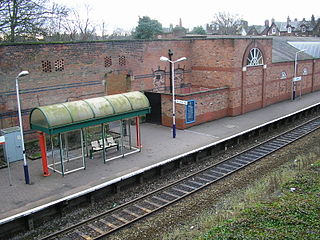
Lytham railway station serves the town of Lytham St Annes, Lancashire on the Blackpool South to Preston railway line.
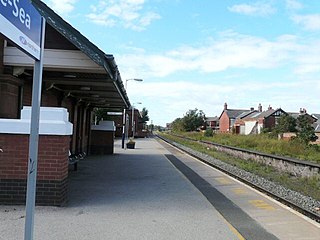
St Annes-on-the-Sea railway station serves the town of St Annes-on-the Sea, commonly known as St Annes, which is part of the conurbation of Lytham St Annes in Lancashire, England. It is located on the Blackpool South to Preston railway line 3 1⁄4 miles (5.2 km) south-southeast of Blackpool South.

Kirkham and Wesham railway station serves the Lancashire towns of Kirkham and Wesham, in England. It is managed by Northern Trains, who operate most of the passenger services that call there.
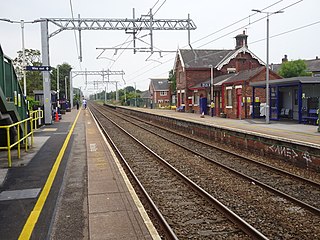
The Blackpool branch lines run from the West Coast Main Line at Preston to Blackpool. The branch further splits into two branches at Kirkham and Wesham junction: the main electrified double track branch runs to Blackpool North station via Poulton-le-Fylde, while a single track unelectrified branch runs to Blackpool South station via Lytham.
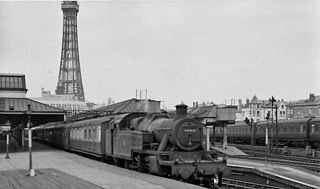
Blackpool Central was the largest railway station in the town of Blackpool in the county of Lancashire, England. It contained 14 platforms; at its closure in 1964, it became the station with the highest number of platforms ever to close. Principal railway services to Blackpool now terminate at Blackpool North.
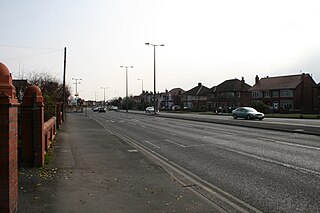
The A583 is a primary road from Preston to Blackpool in England, via Kirkham. It runs a distance of 17 miles, and was previously the main route into Blackpool until the construction of the M55 motorway.
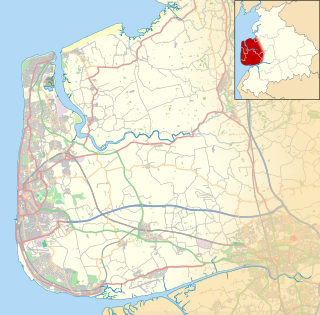
The Fylde is a coastal plain in western Lancashire, England. It is roughly a 13-mile-long (21-kilometre) square-shaped peninsula, bounded by Morecambe Bay to the north, the Ribble estuary to the south, the Irish Sea to the west, and the foot of the Bowland hills to the east which approximates to a section of the M6 motorway and West Coast Main Line.

Elswick is a rural village and civil parish on the Fylde coast of Lancashire, England. At the 2011 Census, it had a population of 1,079.
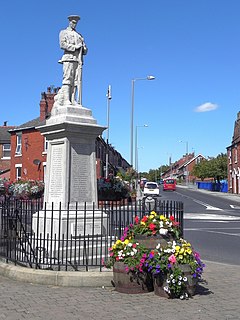
Medlar-with-Wesham is a civil parish and an electoral ward on the Fylde in Lancashire, England, which contains the town of Wesham. It lies within the Borough of Fylde, and had a population of 3,245 in 1,294 households recorded in the 2001 census. rising to 3,584 at the 2011 Census.

St Michael's Church is in the town of Kirkham, Lancashire, England. The church is recorded in the National Heritage List for England as a designated Grade II* listed building. It is an active Anglican parish church in the diocese of Blackburn, the archdeaconry of Lancaster and the deanery of Kirkham.

Westby-with-Plumptons is a civil parish in Lancashire, England. The parish is in Fylde district and contains the hamlets of Great Plumpton, Little Plumpton, Lower Ballam, Higher Ballam, Moss Side, Peel, and Westby. At the 2011 census, the parish had a population of 1,205. Westby and Plumpton are mentioned in the Domesday Book, as "Westbi" and "Pluntun".

The Carnegie Library is in Lytham St Annes, Lancashire, England. The foundation stone of St. Anne's Library was laid in August 1904 and the building was officially opened on 10 January 1906. The land was given by the St. Anne's on the Sea Land and Building Company, and Andrew Carnegie paid for the building itself. This was the first library in the town. There is also a library at Lytham.






















